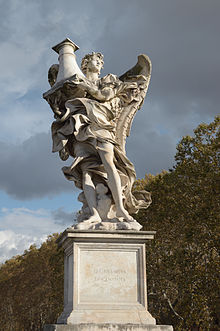Antonio Raggi
| Antonio Raggi | |
|---|---|

Angel with the Column, Ponte Sant'Angelo, Rome.
|
|
| Born | 1624 Vico Morcote, Ticino |
| Died | 1686 Rome |
| Nationality | Swiss-Italian |
| Education | Gianlorenzo Bernini |
| Known for | sculpture |
| Notable work | Death of Saint Cecilia, Baptism of Christ, Angel with the Column |
Antonio Raggi (1624–1686), also called Antonio Lombardo, was a sculptor of the Roman Baroque, originating from today's Ticino.
He was born in Vico Morcote on the Lake Lugano. His mentor in Rome for nearly three decades was Gianlorenzo Bernini. He initially joined the studio of Alessandro Algardi, but none of his work there is independently recognized and by 1647, like Ercole Ferrata, Raggi was working for Bernini, for whom he was to become his closest and most prolific pupil. "In most cases Bernini supplied Raggi with detailed modelli and supervised his work closely enough so that Raggi's statues express Bernini's conceit almost as well as a statue from Bernini's own hand."
He completed the stucco decoration of San Tomaso di Villanova in Castel Gandolfo (1660-1), the stucco decoration of Bernini's Sant'Andrea 1662-1665), the statues of Saint Bernardino and Pope Alexander VII Chigi for Duomo di Siena and the Virgin and Child in Saint Joseph des Carmes in Paris (1650–51). He made the Baptism of Christ for Borromini's altar of San Giovanni dei Fiorentini (c. 1665). Recently discovered documentation shows that he provided the kneeling figure of Saint Bernardino of Siena (1656–57) in Alexander VII's chapel at Santa Maria della Pace, and the two pairs of putti holding portrait medallions on the façade.
His masterpiece is the marble relief of the Death of Saint Cecilia, in the church of Sant'Agnese in Agone, Piazza Navona. Here it can be contrasted with the relief by Algardi's pupil Ercole Ferrata, of the Stoning of Santa Emerenziana.
...
Wikipedia
